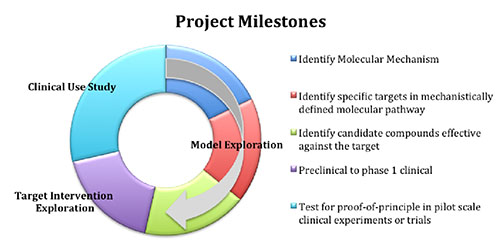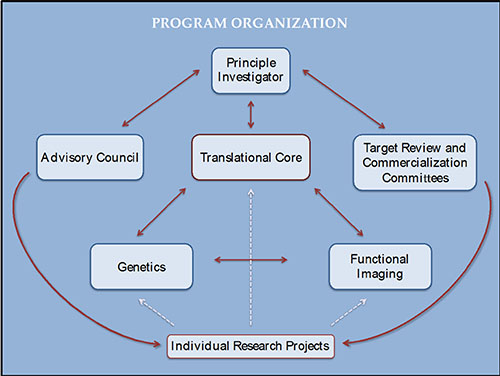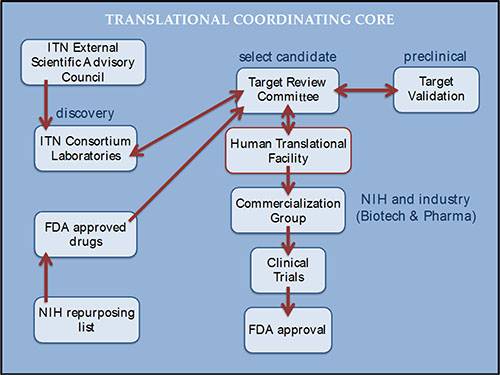Alcohol and Substance Abuse Disorders



Posted May 5, 2015
Jennifer Mitchell, Ph.D.; University of California, San Francisco (formerly Institute for Molecular Neuroscience; Ernest Gallo Clinic and Research Center)
 Alcohol and prescription drug abuse are of particular interest to the Department of Defense due to their high prevalence among the military population in comparison to civilians. In response to the growing concern regarding alcohol and substance abuse disorders (SUDs) in both the military and general public, and the need for new and effective medications, the Institute for Translational Neuroscience (ITN) at the University of California, San Francisco was established with congressionally directed funding in 2010. Now in its fourth year of operation, the ITN has formed a unique and promising strategy to accelerate the development of novel therapeutics for SUDs.
Alcohol and prescription drug abuse are of particular interest to the Department of Defense due to their high prevalence among the military population in comparison to civilians. In response to the growing concern regarding alcohol and substance abuse disorders (SUDs) in both the military and general public, and the need for new and effective medications, the Institute for Translational Neuroscience (ITN) at the University of California, San Francisco was established with congressionally directed funding in 2010. Now in its fourth year of operation, the ITN has formed a unique and promising strategy to accelerate the development of novel therapeutics for SUDs.
The ITN is a consortium comprised of 18 institutions that seek to identify new medications for SUDs through a standardized approach. The scientific objectives of the ITN are to (1) identify molecular mechanisms, targets, and candidate compounds; (2) determine the efficacy of the candidate compound(s) in vitro and in vivo (animal models); (3) conduct proof-of-principle pilot scale clinical experiments or trials; and (4) rapidly translate findings into full-scale clinical experiments/trials. To facilitate the transition from bench to bedside, the ITN also established a Translation Coordinating Core with the goal of attracting collaborations with interest from outside sources, such as the National Institutes of Health and commercial pharmaceutical and biotechnology companies, to support follow-on clinical trials to promising ITN projects.
The ITN also established an Advisory Council, consisting of members from the government, academia, and industry, to provide strategic advice, set research priorities, and serve as the primary external scientific and programmatic review for proposed research projects. The following projects are examples that represent different aspects of the ITN portfolio, and together depict the typical movement of research through the ITN approach.
Clinical Proof-of-Principle (PoP) project pitched from preclinical data:
 Glial Regulators for Treating Comorbid Posttraumatic Stress Disorder (Injury) and Substance Abuse Disorders; Peter W. Kalivas, Ph.D.; Medical University of South Carolina
Glial Regulators for Treating Comorbid Posttraumatic Stress Disorder (Injury) and Substance Abuse Disorders; Peter W. Kalivas, Ph.D.; Medical University of South Carolina
Potential and Importance: This study seeks to determine the efficacy and safety of N-acetylcysteine (NAC) in preventing relapse and reducing drug craving and post-traumatic stress disorder (PTSD) symptoms among Veterans with comorbid PTSD and SUDs. The investigation of the role of glial pharmacology in PTSD/SUD is of very high importance as this is a novel approach to an important problem that does not yet have a solution.
Progress: In a 12-week study of 30 participants, craving was reduced by 82% in the NAC group (n=15) between weeks 0 and 12, compared to only an 18% reduction in the placebo group (n=15). Similarly, the Clinician Administered PTSD Scale (CAPS) total score revealed an overall reduction in the NAC group of 33 points from weeks 0 to 8 (treatment phase), while the placebo group showed an average reduction of 17 points and at no time was significantly below a diagnostic range for PTSD (a CAPS total score of ≥ 50 represents the criterion for diagnostic PTSD).
Clinical PoP:
 Catechol-O-Methyltransferase, Impulsivity and Substance Abuse Treatment; Andrew Kayser, M.D., Ph.D. ;University of California, San Francisco
Catechol-O-Methyltransferase, Impulsivity and Substance Abuse Treatment; Andrew Kayser, M.D., Ph.D. ;University of California, San Francisco
Potential and Importance: This study seeks to determine (1) whether tolcapone, a COMT (catechol-O-methyltransferase) inhibitor, will preferentially reduce impulsivity in individuals with the val/val 158 genotype and produce commensurate changes in central nervous system circuits involved in intertemporal choice and (2) whether the effect of COMT inhibitors on impulsivity depends upon their ability to cross the blood-brain barrier. These studies have the potential to enhance our understanding of the relationship between impulsivity and SUDs and to identify drugs that could treat SUDs through reducing impulsivity.
Progress: Behavioral data show a range of responses to tolcapone, but an overall effect of decreased impulsive choice ratio (ICR) on tolcapone versus placebo. More importantly, the magnitude of this effect in individual subjects correlates inversely with baseline Barratt Impulsivity scores (r = -0.45, p = 0.03); i.e., subjects with greater impulsivity scores at baseline show larger reductions in ICR on tolcapone. These effects are accompanied by a general enhancement of frontal and visual association cortices on tolcapone versus placebo.
Preclinical PoP to clinical extend and confirm:
 Endogenous Modulators Suppress Substance Use Disorders Associated with Chronic Stress; Jacqueline F. McGinty, Ph.D.; Medical University of South Carolina
Endogenous Modulators Suppress Substance Use Disorders Associated with Chronic Stress; Jacqueline F. McGinty, Ph.D.; Medical University of South Carolina
Potential and Importance: This study directly addresses the core goal of ITN to identify candidates to treat SUDs by investigating whether oxytocin (OT) and carbetocin can ameliorate reinstatement of methamphetamine abuse in rats after being subjected to repeated traumatic stress.
Progress: Self-administration (SA) of methamphetamine in rats after pre-exposure to TMT (predator odor) was significantly higher than in rats pre-exposed to saline (control). When both groups were pre-treated with OT, methamphetamine SA was significantly lower in both groups. These results indicate that OT suppresses drug-seeking with or without pre-exposure to predator odor-induced stress, indicating that OT is a promising therapeutic target for traumatic stress and SUD vulnerability.

















